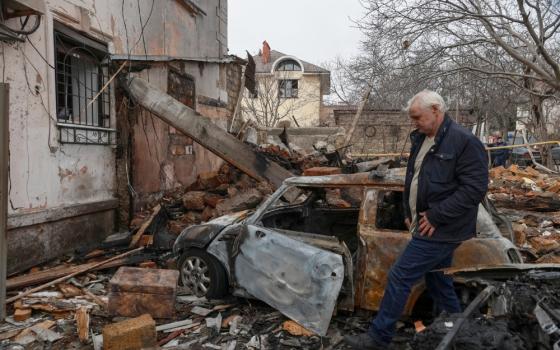Two issues of grave import for the Catholic church are vying for my attention right now. The first is the tragedy and trauma of parish closings seen most recently in the diocese of Winona, Minn., and the archdiocese of New York.
The second is a newly energized chorus of ecclesial voices calling for married priests.
In November, New York's Cardinal Timothy Dolan announced he would merge 112 of the archdiocese's 368 parishes, effectively closing 31 of them where regular services would no longer be held. Adding insult to injury, the archdiocese announced in mid-December a second plan to merge 38 more parishes, of which 11 would effectively close.
While no final decisions have yet been made, the second plan quickly roused the ire of a respected Wall Street Journal columnist, Peggy Noonan, who wrote an open letter arguing the archdiocese was wrong to close her parish. Citing overflow liturgies, a diverse population, solid finances, a successful school and a legacy of religious vocations, Noonan accused the archdiocese of wanting cash from the sale of the Church of St. Thomas More, which is located on prime real estate on Manhattan's Upper East Side. Likewise, she said: "The archdiocese is defensive about closing churches in poor areas. What better way to comfort themselves, and avoid bad press, than closing one in an affluent area?"
Meanwhile, parishioners from at least 18 New York parishes decided to appeal November's decisions. But the archdiocese essentially stonewalled their efforts by refusing to provide copies of the canonical decrees to which they have a right and which they needed to take their case to Rome. Only after parishioners sought recourse asking Rome to require the archdiocese to release the decrees did they finally appear on the archdiocesan website. (Full disclosure: I am in regular communication with a number of New York parishioners via my volunteer work with FutureChurch's Save Our Parish Community project.)
Needless to say, such archdiocesan antics did little to preserve trustful relationships between New York Catholics and their cardinal-archbishop. Instead, they seemed to energize appeal efforts that will likely take years to resolve, if the 2009 successful Cleveland appeals are any indication.
In addition to demographic changes and finances (both disputed by parish leaders), a prominent reason cited in each canonical decree is that "the Archdiocese faces a decline in the number of available priests." While I agree with Noonan that the need for ready cash is likely an important factor, another major driver is the steadily increasing shortage of priests. According to the Official Catholic Directory, in 1991, the New York archdiocese had 2,177 priests serving 2.24 million Catholics in 411 parishes, for a ratio of 1 priest for every 1,030 Catholics. In 2013, there were 1,343 priests serving 2.62 million Catholics in 368 parishes for a ratio of 1 priest for 1,950 Catholics.
But the real-world situation is even worse. The Center for Applied Research in the Apostolate found that just 68 percent of diocesan priests are actually available for active ministry, and active diocesan priests will continue to decline for the next 20 years.
In late November, in response to a request by Brazilian Bishop Erwin Krautler to ordain married men, Pope Francis urged the world's bishops' conferences to develop "courageous" proposals to deal with the priest shortage. Like most of the developing world, Krautler's diocese is experiencing eucharistic famine, since there are only 27 priests to serve over 800 Catholic congregations. In early February, the Association of U.S. Catholic Priests publicly requested the U.S. Conference of Catholic Bishops to "start the dialogue" about married priests in light of an "overwhelming" workload and "alarming" parish closures and mergers.
Currently, FutureChurch is conducting an online open letter asking U.S. bishops to open discussion of early church traditions permitting married and celibate priests as well as female and male deacons. Meanwhile, Eastern-rite Catholics are rejoicing that last year, Pope Francis finally lifted a generations-old ban on married priests, restoring a cherished historical custom.
Then there are my friends Phil and Linda Marcin, a married priest couple who do not regard Phil as an "ex-" or "former" priest, but "like St. Peter a married priest ready to serve." Linda relates a not uncommon scenario:
"Several years ago, both of our parish priests became ill. Daily Mass was suspended and the hunt was on for someone to fill in on Sunday. At Mass, Phil sat only a few steps away from the altar. He had volunteered to fill in and was thanked by the priests who were most willing to accept his offer but were prevented by church law."
Just last week, Pope Francis brought a ray of hope for priests who left the active ministry to marry. He told Rome's clergy he had recently celebrated Mass with five priests celebrating their golden jubilees, and five priests who left the priesthood to marry were also present. Press reports indicate Francis considers this to be an important question for the church.
Some fear opening ordination to married men will put full acceptance of women's priestly calls on indefinite hold. I used to feel this way myself. But I have come to agree with the late Richard Schoenherr, whose book Goodbye Father wisely contended: "Saying good bye to celibate exclusivity means eventually saying goodbye to male exclusivity. We will discover that a married clergy is still anathema for most of the Catholic hierarchy because it is the camel's nose under their patriarchal tent ... gender inclusivity must be preceded by the introduction and routinization of marital-status inclusivity in the priesthood."
Overcoming centuries-old celibate exclusivity in the priesthood will not be easy. But if celibacy really is a gift of the Spirit, why are we so afraid to allow the Spirit to do her thing and permit it to be optional for diocesan priests? Do we really think the celibate charism will disappear if we allow priests to choose it freely?
What kind of trust in the Holy Spirit is that?
Can a gift truly be a gift if it isn't freely given and freely received? True gifts do not coerce. When will we finally believe the priests who tell us the Spirit has gifted them for the priesthood but not for celibacy? It is a distortion of the gift of celibacy to demand it of those called to priesthood but not to celibacy.
I'm called to celibacy myself. I love this lifestyle because it is the best way for me to experience and witness to the God of love. But much as I love my own path, I also know that our church needs spiritual leaders who are as diverse as we are. We need married priests, celibate priests, gay and straight priests, black, white, and brown priests, male priests and yes (gasp), female priests.
I deeply dislike the notion that the celibate spiritual path is some sort of an "inside track" to the holy mystery of God. Jesus really hated it when his disciples argued about who was greatest in God's kingdom. His idea was that the greatest is the one who loves the most and serves the least ones. Jesus leaves us free to choose the lifestyle that will best help us love deeply and serve humbly -- a choice that will necessarily be different for each of us.
Here is my question for church leaders, apparently so fearful of celebrating both celibate and married priestly calls:
Why do you have so little trust in the Spirit that you seek to control God's gifts?
[A Sister of St. Joseph, Sr. Christine Schenk served urban families for 18 years as a nurse midwife before co-founding FutureChurch, where she served for 23 years. She holds master's degrees in nursing and theology.]
Editor's note: We can send you an email alert every time Christine Schenk's column, Simply Spirit, is posted. Go to this page and follow directions: Email alert sign-up.




